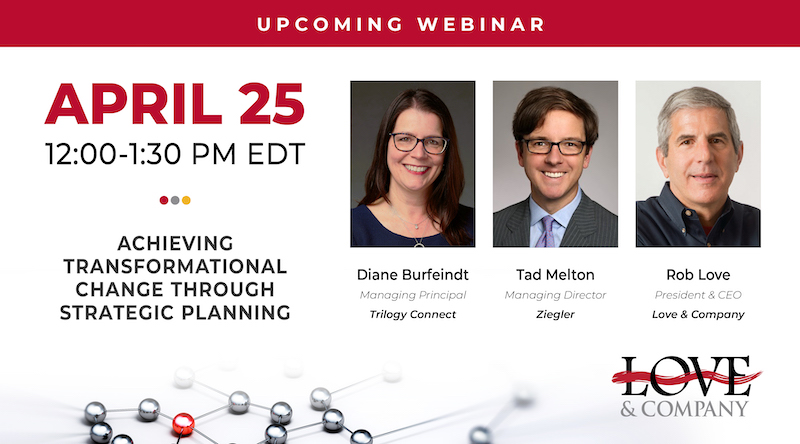In her recent blog, “How to Lay the Foundation for an Effective Strategic Planning Process,” Diane Burfeindt, my co-presenter in our upcoming webinar on strategic planning and the managing principal of Trilogy Connect, addressed the reasons it’s important to fully educate boards on the issues facing senior living organizations so that the board can contribute to the development of an effective strategic plan. In this article, I will address a few specific examples of board education that I feel are important.
Improve Financial Literacy
Over my 20+ years in senior living, I’ve been surprised by how many boards of directors don’t have a functional understanding of their organization’s financial situation or the basic economics underpinning a Life Plan Community. At one community, a board member was on the board for 20 years and didn’t understand the need to grow to create the capital capacity to finance large-scale updates to the community. Without that understanding, it’s a challenge to have productive discussions around the need to make the necessary capital investments to improve non-revenue-generating amenities to stay competitive in the marketplace.
How boards get information is important. Financials are often shared in an operational, nuts-and-bolts format. That doesn’t help everyone understand a concept like capital capacity.
Sometimes a board will get a forward-looking pro forma, but it often just rolls the budget out a few years and doesn’t model the effects of changes in the relationship between expenses and revenue over time. As a result, the organization may get a few years down the road, need capital, and find out too late that there was a problem brewing all along. This has become even more important over the past few years where, for much of the field, operating and capital expenses have inflated faster than resident fees.
When a CEO has a strategy they’d like to pursue but can’t afford, they’ll model scenarios to enable implementing the strategy. That’s modeling reactively. If our field could get in the habit of modeling proactively, that would be transformative.
Over time, small changes that may not seem important individually can have a huge impact on an organization. For example, are entrance fees rising at the level that construction costs and home resale values are increasing? Today, the ability to add financial capacity by expanding is hindered by higher interest rates and rising construction costs. If a community had been more proactive in monitoring the relationship between its entrance fees, home resale values and construction costs over the past ten years, it could be in a significantly stronger capital position today.
View Affiliations as Opportunities
In the past, affiliations were often undertaken as a reaction to a community or organization failing. More and more though, organizations are having proactive conversations about affiliations as opportunities to capitalize on synergies that can strengthen both parties. Yet, for many boards, it is still difficult to look at strategic partnerships and relationships when they aren’t faced with an immediate, compelling crisis, even when the CEO can see a crisis on the horizon.
Whether the impending concern is a financial runway of less than a year, an upcoming CEO retirement, a lack of leadership depth, or the current cost escalations, it can be difficult to coach boards in fulfilling their fiduciary role by planning for the long-term success of the organization. For example, single-site or small multi-site organizations are finding it increasingly difficult to afford a full complement of back-office functions, like IT and HR support, and could benefit from opportunities to form partnerships to achieve economies of scale.
With a strategic plan in place, the organization can take a look at where it faces roadblocks to implementation. What do they want to accomplish that they’ve been unable to achieve? Those are areas where they may find success with partnerships.
Is It Time to Consider Alternative Board Structures?
An essential component of strategic planning is the CEO building consensus with the board on a vision that achieves the organization’s mission in a constantly evolving set of demographic, programmatic and economic trends. This can sometimes be a challenge with a large volunteer board.
With my experience working with boards, I’ve reached a conclusion: Smaller, paid boards tend to commit more attention to the nuances of the business. When managed properly, a paid board can be a dynamic partner for executives. Being a volunteer board member myself, I know how long it takes to understand the depth of an organization’s makeup and the strategic position of the non-profit in relation to its field. Developing a board that truly understands the CEO’s vision, then offers the insights and expertise needed to further shape that vision, could be a powerful strategic asset.
More organizations might consider compensating board members. In creating such groups, board members with strong financial and organizational leadership skills who know what it takes to guide an organization to success could be recruited. Right now, I am not aware of many paid boards. The ones I am aware of tend to be smaller and more focused, but there aren’t enough to draw firm conclusions. It’s the beginning of what I believe needs to be a new trend in the field.
Planning for Success
Senior living is facing unprecedented financial challenges. At the same time, our market is growing. We’re at an inflection point, and organizations that strategically plan for success are those most likely to achieve it. Just because the aging demographics should bring more residents to our communities doesn’t mean our field is guaranteed success. To quote Will Rogers, “Even if you’re on the right track, you’ll get run over if you just sit there.”





